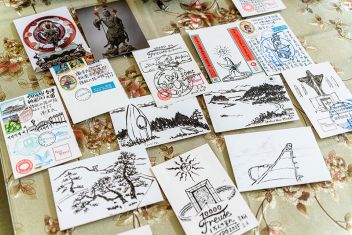
The TRA’s R100 diesel engine, whose passing is much lamented by train buffs. Although it can’t pull trains at top speeds, it is well suited to “slow travel.”
They came to capture images of trains against the backdrop of the blue ocean at the mouth of the Jiajinlin River in Taitung County’s Dawu Township or at Duoliang in Taimali Township. All last year train buffs headed to locations along the South Link Line in Taitung and Pingtung to snap images of its scenery before electrification cluttered the line with poles and before the last of Taiwan’s blue-and-white liveried commuter trains were taken out of service.
Opened in 1991, the South Link Line was the last segment of railway needed to encircle the island. In 2020, the Taiwan Railway Administration (TRA) completed the full electrification of the South Link Line—just in time for its 30th anniversary, in 2021. While speeds have increased, the South Link Line is more than merely a means of transportation: It also holds many stories and offers great scenic views. It is a line that provides a look at “a different side of Taiwan.”
Engineering, most difficult
“The South Link Line resembles a Nike swoosh.” So describes Hsiao Chu-chen, who is shooting a documentary about the people who built the line. Starting from Fangliao in Pingtung, the line climbs and descends for nearly 100 kilometers before reaching its terminus in Taitung.
Taiwan’s railway system was largely planned and constructed by the Japanese, and most of it was finished before World War II. All that was missing was a northern link (from Su’ao to Hualien) and a southern link (from Fangliao to Taitung). The northern segment was opened in 1980, whereas the missing southern link would not be finished until 1991. Electrification would likewise come first to the North Link Line in 2003 and then to the South Link Line last year, marking the start of a new era for Taiwan’s railways.
In fact, a railway to link Pingtung and Taitung was proposed as far back as the Japanese colonial era, but the complex geology posed immense engineering challenges. “With 80% of the track in tunnels or on viaducts, you can imagine how difficult construction was,” says Hsiao. “Back when they were building the North Link, Japanese consultants provided assistance, but the South Link Line was entirely built by Taiwan’s own civil engineers.” After leaving Fangshan, the South Link Line passes through an area that was almost completely uninhabited and had no roads. It was difficult to bring in materials, and they had to perform all the surveying themselves. Moreover, they had to deal with powerful foehn winds in the Fangye-Guzhuang section of the route and overcome tremendous difficulties to span the Central Mountain Range. There are 36 tunnels along the line, which took 11 years to finish. The hard work of the engineers and their success in building the South Link Line are both deserving of a page in the engineering history of Taiwan.
A line most scenic
Apart from being an engineering marvel, the South Link Line also features outstanding scenery.
Fangliao Township is known for its Irwin mangoes. When you ride south from Fangliao Station in March or April, you are greeted with expanses of blooming mango trees. Then in May and June you can see the same trees laden with fruit. Going farther south, where the mountains meet the sea, you reach Fangshan Station, the TRA’s southernmost stop and a well-known spot to take in the sunset.
When the train pulls out of Fangshan Station, it says goodbye to the Taiwan Strait and begins to wind through the Central Mountain Range. The landscape here bears few human traces. There are no settlements along the line, only forests and green river valleys. Railway buff Ku Ting-wei needs to rough it when he explores these parts. In his quest for good photographic vantage points, he climbs mountain trails, bushwhacks, ascends power-line towers, and treks through remote orchards. Amid the mountainous terrain he captures images of trains exiting tunnels on forested hillsides or passing along riverbeds—scenes rarely glimpsed elsewhere in Taiwan.
After the train passes through the Zhongyang Tunnel (the line’s longest) and Guzhuang Station, it leaves behind the mountains for the East Coast. Some time later we flash through Duoliang Station—what nature and travel writer Liu Ka-shiang describes as a “tenth-of-a-second beauty.” Trains no longer stop here, but with its mountainside perch and elevated platform design, it offers a beautiful glimpse of the blue ocean that leaves a big impression, however fleeting the view. Once the train passes Kangle Station, the scenery turns into golden rice fields, and the fruits in the orchards become sugar apples, providing a tropical atmosphere as the train approaches its destination of Taitung.
With its high mountains and expansive ocean vistas, its natural magnificence and rich cultural history, the South Link Line offers a full-course scenic feast and a journey that will linger in travelers’ memories.

Lacking air conditioning, these blue trains relied on aging ceiling-mounted fans for air circulation.
The best solution for the “blues”
The blue local “ordinary trains” that have been running on the South Link Line provide another superlative.
After the electrification of the South Link Line, the TRA also announced that the blue locals that had previously plied this route would be relegated to history. While the trains running services 3671 and 3672 had always held a special meaning for train buffs who knew they were the last of the blue locals, their imminent demise brought them more general renown in 2020: When train 3671 would leave Fangliao Station at 11:28 a.m. and train 3672 would pull out of Taitung at 4:15 p.m., they were always full of passengers.
The blue trains that made these runs all had at least 50 years of service. Instead of air conditioning, they relied on ceiling fans and windows that slid up for air circulation. The funky-smelling bathrooms still had chemical toilets that were flushed with recirculated liquid. Diesel smoke from the engine would waft into the carriages and the rumbling sounds of the train filled one’s ears. Ku Ting-wei doesn’t pull his punches: “The blue cars were eliminated because they don’t meet contemporary needs.”
As early as 2011 Liu Ka-shiang, long a promoter of “slow tourism,” was advocating for their preservation. He wrote several guest columns for newspapers, arguing that the TRA should keep those blue trains—and not just for the sake of preserving a sense of the blue-car era: “I felt that we needed a slow-travel train.”
Another source of the reluctance to let these trains pass into history comes from nostalgia for the 1950s and 60s. On the day these blue trains made their last runs, many parents brought their children to experience the trains that they had ridden as students. Back before car ownership became widespread, trains were important public transportation, with journeys away from home for work or study relying on the railways for leaving and returning. Trains were intimately connected with the common people’s lives.
Most memorable of experiences
“For Taiwanese over 40, their memories of leaving home—whether to study, to perform their military service, or to work—are almost all connected to trains,” observes Hsiao Chu-chen.
Hsiao, the director of documentaries such as The Red Leaf Legend and Grandma’s Hairpin, has turned her focus to trains over the last four years. Originally, she had wanted to shoot a documentary about the round-the-island railway as a way of explaining Taiwan. “Many cities and towns in Taiwan grew up around their train stations, which is something that has never been adequately explored.” But because that topic was too broad, she decided to put her focus on “the changing South Link Line.”
Hsiao also teaches about Taiwanese film at National Tsing Hua University, and she has studied how trains appear in New Taiwanese Cinema. “In the early memories of ordinary people in Taiwan, trains play an important role.”
Trains link places to each other, and they can take you around the island. “But there’s more to it than that: Taiwan’s small area doesn’t mean that we have a better understanding of its varied locales and a greater familiarity with the stories connected to each place,” says Hsiao, expressing her concerns. As a director of documentaries, she has a deep knowledge of stories about Taiwanese localities, but in the process of shooting footage about the South Link Line, she discovered that even she knew little about the localities along it, such as local indigenous communities, and communities created by the resettlement of refugees from islands off the coast of Zhejiang that came under Chinese Communist control in 1955.
She was deeply moved by something that one of the tunnel engineers told her. “The short eight kilometers of the Zhongyang Tunnel required eight years of tunneling,” Hsiao recounts him saying. “Now that you can zip through it in just a few minutes, you don’t realize what we went through back then.” She thus made it her mission to make a record of such stories and to uncover more of them. “With stories, connections are made,” says Hsiao with much emotion. “For instance, I now feel a connection to the South Link Line.”
One student heard her expounding on this topic and told her, “Teacher, the next time I ride through the Zhongyang Tunnel, I definitely won’t doze off. I’ll do my best to take a good look.” “Yet it’s total darkness within the tunnel,” Hsiao notes, smiling, “so I don’t know what she’ll be able to see!” Still, understanding stories about places forges connections between people and the local scenery, bringing people closer to the land.
Slow and scenic
“With the opening of the freeways in Western Taiwan, TRA lost its competitive advantage for long-range travel,” notes Ku Ting-wei. “At that point, only the North Link and South Link lines to Eastern Taiwan could still compete with highway travel. But now, with the completion of the Su’ao-Hualien highway improvements and the South Link Highway expansion project, it’s a completely new era.” He also points out: “There is only a small commuting population in Hualien and Taitung. Tourism will have to be the major driver of future revenue for the South Link Line.”
In that vein, the South Link Line will perhaps change the way that the people of Taiwan know and experience railway travel. Liu Ka-shiang, as an advocate of “slow travel,” says: “Slow travel isn’t just about it being slow. Rather, it’s about slowing down enough to appreciate the differing scenery, customs and cultures of Taiwan. ‘Slow’ doesn’t really mean ‘slow,’ but instead means taking the time to experience different visions and landscapes.”
Liu has had a familiarity with the South Link Line since he was young. These days he takes a museological approach: When he visits Dawu Station, he mentions that it is in the homeland of the Formosan spotted leopard. He notes that the whole line, from Fangshan to Taitung, passes through the land of the Paiwan people, and thus provides an experience of going abroad without having to leave the island of Taiwan. Connecting interesting stories such as these to the places one visits demonstrates the ethos of “slow travel.”
The railways are more than mere routes of transportation. To be sure, the electrification of the South Link Line has reduced journey times, improving the efficiency of point-to-point travel. But beyond providing speedy transport, Taiwan’s railways even more offer “a way to see a different side of Taiwan,” says Liu.











